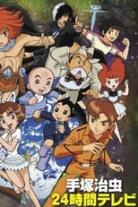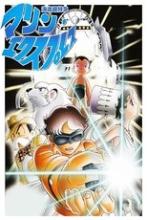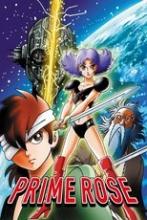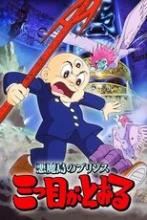
24 Hour Television Specials
Features aired during the annual 24 Hour Television: “Love Saves the Earth” telethons on Nippon Television Network.
One Million-Year Trip: Bander Book (1978)
27 August, 1978
Bander is a 17-year-old boy from Earth who lives on a distant planet, which is populated by human shape-shifters who feed off of vegetables and animal tails. Violence soon breaks out, as invaders launch an attack on Bander's new planet. This was Japan's first 2-hour animated film for television. The program received high ratings when broadcast as part of a set of 24-hour TV programs called "Ai wa Chikyu wo Sukuu" on Nippon Television. After a long gap since his last animated film for television, this work fully reflects Osamu Tezuka's desire to achieve theatrical quality with this production.
Undersea Super Train: Marine Express (1979)
26 August, 1979
The plot of Marine Express can be described in two parts. The first part focuses on the people boarding the train and the problems they encounter on it. The second part takes place after the train has stopped at its half-way point, an island that used to be home to an ancient civilization millennia ago and has its fair share of secrets.
Fumoon (1980)
30 August, 1980
Nuclear testing has resulted in the abrupt evolution of the Fumoon, a tiny but highly intelligent humanoid race on a small island, who are detected by Dr. Yamadano. Except for a few witnesses including the detective Shinsaku Ban, and the young men Rock and Kenichi and Kenichi’s sister Pichi (Pinoko), no one believes him. The Fumoon are kidnapping animals from around the world to bring with them as they use their space ships to evacuate the earth, because they know Earth is shortly to be destroyed by an enveloping cloud of black gas created by a stellar explosion. The Fumoon intend to abandon mankind, but one Fumoon, Rokoko, who becomes good friends with Kenichi, tries to help Dr. Yamadano and the others to develop a space ship to allow a few humans to escape, with the help of Dr. Ochanomizu and Dr. Frankenstein.
Bremen 4: Angels in Hell (1981)
28 August, 1981
The story concerns four animals fighting to expel war from the earth. Though based on the "Band of Bremen (Die Bremer Stadtmusikanten)", Tezuka Osamu's fans could easily associate the story with "The Amazing Three." The cat, dog, donkey, and chicken who transform into human beings with the power of spacemen and fight to save the earth are entirely reminiscent of the three characters in the "Amazing Three" who transform themselves into animals and devote all their energies to saving the earth.
A Time Slip of 10,000 Years: Prime Rose (1983)
21 August, 1983
A powerful entity known as Death Mask hurls Kujukuri City, Japan, and Dallas, Texas 10,000 years into the future, reshaping them into a ruthless battleground where only the strongest survive. Determined to shatter this tyrant's hold on time itself, Gai Tanbara ventures into the dystopian future. Along the way, he meets Emiya, a fierce warrior fighting to reclaim her city from the darkness. Together, they confront the horrors of a shattered world and the sinister forces threatening the fate of humanity!
Bagi, the Monster of Mighty Nature (1984)
19 August, 1984
In 1984 the Japanese government approved gene recombination experiments. Baggy is Tezuka’s response. A cute kitten escapes a lab, and is befriended by lonely child Ryosuke. Years later, he joins her in a quest that’s part spaghetti Western, part contemporary adventure.
The Three-Eyed One: The Prince of Devil Island (1985)
25 August, 1985
Sharaku and Wato investigate a mysterious old ship, only to find themselves getting involved in a sea voyage around strange islands.
Galaxy Investigation 2100: Border Planet (1986)
24 August, 1986
Tezuka Osamu crafts a love story in the time when humans are expanding into space at the end of the 21st century, employing an omnibus form similar to Bradbury's "Martian Chronicle." Leaving the earth after marriage, a woman is left behind in space when her husband suddenly dies of a cosmic disease. Her friends on the Earth head for space to save the woman who was once everyone's ideal lady. Tezuka Osamu emphasizes his concepts that "love can save the earth" and "only love can save humans."
The Tale of Osamu Tezuka: I'm Son-Goku (1989)
27 August, 1989
A semi-autobiography of Tezuka Osamu combined with a 30 minute science-fiction setting of Journey to the West.









